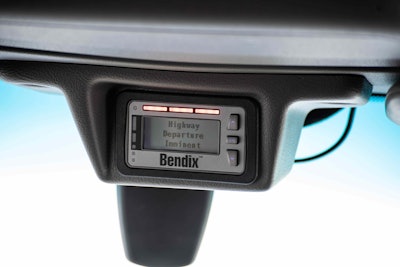
Introduced in 2015, Bendix Wingman Fusion provides rear-end collision mitigation, along with adaptive cruise control, following distance alerts, stationary object alerts, lane departure warning, overspeed alerts and action, and alerts and braking on stationary vehicles. Fusion also helps drivers mitigate potential rollovers and loss-of-control situations by integrating the full-stability Bendix ESP Electronic Stability Program as a foundation.
“The new Wingman Fusion does more and performs better with no need to accommodate new hardware. This upgrade is an ideal reflection of the Bendix approach to these technologies, which envisions each step as a foundation for the next – an ever-expanding platform of software, sensors, and system integration to build even more potent vehicle and highway safety systems to help drivers navigate more situations safely,” says Bendix Director of Customer Colutions – Controls, Fred Andersky. “The more sensors we integrate, the more information the system gathers about the vehicle and its surroundings – and all that data is the key to the system’s decision-making process when it comes to keeping drivers safe.”
Andy Pilkington, Bendix’s ADAS product manager, says the system’s next-generation enhancements enable Fusion to now provide full braking power on the tractor – a boost from two-thirds power previously – along with pulsing air to the trailer brakes. This provides trailer braking regardless of whether or not the trailer has an ABS/TRSP unit.
Combined with improved sensor and data analysis, the system can reduce a vehicle’s speed by as much as 50 miles per hour – a speed reduction improvement, Pilkington says, of 40 percent over prior generation technology.
With the new multi-lane automatic emergency braking feature, if Fusion applies the brakes due to a vehicle in the lane ahead and the truck driver moves to an adjacent lane, the system will continue applying the brakes if it detects another car ahead in the new lane – helping the driver avoid both the first and potentially the second situation.
Fusion’s new highway departure braking capability builds on the system’s existing lane departure warning technology to alert the driver and apply the brakes if needed when it determines the vehicle has left the road.
ACB Stop & Driver Go is a low-speed variable to adaptive cruise control for traffic situations allowing the driver to resume cruise control after braking to a stop without the need to push the resume switch.
The ACB Auto-Resume functionality reengages cruise control after Fusion brakes the vehicle above a certain speed threshold. Using previous technology, the cruise control disengages if the system brakes. With ACB Auto-Resume a driver won’t have to resume cruise if the system brakes and certain parameters are met.
The enhanced product suite will launch in 2019. Most major North American truck brands offer Fusion as standard on their highway tractors, including Kenworth Truck Company, Peterbilt Motors Company, and Mack Trucks. Volvo Trucks North America offers Volvo Active Driver Assist – which is based on Wingman Fusion – as standard on its VNL and VNR series tractors. Fusion is also offered as standard on the Kenworth T680, Peterbilt Model 579 and the Mack Anthem. Fusion is an option over the standard Wingman Advanced system on International on-highway tractors.
BlindSpotter improvements

BlindSpotter uses a new side-mounted radar unit – typically installed on the passenger side of the vehicle but also available for driver-side mounting – to alert drivers to vehicles or objects in adjacent lanes. Andersky says when connected to the vehicle’s J1939 CAN (controller area network), the system’s new radar operates over a wider field of view than the previous version, allowing it to “see” farther toward both the front and back of a combination or single-unit vehicle – up to 2.5 times farther in each direction compared to the previous generation of BlindSpotter.
Despite the new internals – radar and CAN connectivity – the new BlindSpotter maintains the look, size, position, and mounting hardware of its radar and in-cab display units, which Anderskey says making it easy to upgrade from the current version or retrofit the entire kit.
When connected to the vehicle’s CAN, the new BlindSpotter provides a 150-degree range of coverage capable of detecting objects up to 20 feet in front of and 20 feet behind the BlindSpotter radar. The coverage zone extends up to 10 feet to the right of the vehicle. BlindSpotter minimizes false alerts by operating in two modes: highway speeds and lower speeds. When connected to the CAN and at highway speeds, the sensor filters out stationary objects like guardrails; the slow-speed warning mode – active at less than 20 mph, such as during city driving or in parking lots – narrows the range for alerts and does not filter out stationary targets or infrastructure.












